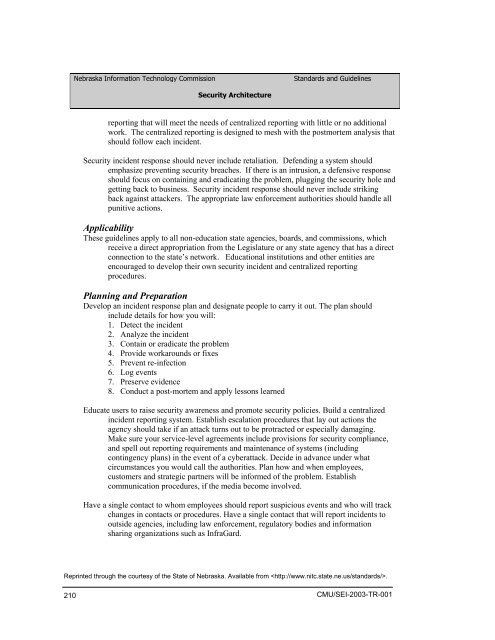State of the Practice of Computer Security Incident Response Teams ...
State of the Practice of Computer Security Incident Response Teams ...
State of the Practice of Computer Security Incident Response Teams ...
Create successful ePaper yourself
Turn your PDF publications into a flip-book with our unique Google optimized e-Paper software.
Nebraska Information Technology Commission<br />
Standards and Guidelines<br />
<strong>Security</strong> Architecture<br />
reporting that will meet <strong>the</strong> needs <strong>of</strong> centralized reporting with little or no additional<br />
work. The centralized reporting is designed to mesh with <strong>the</strong> postmortem analysis that<br />
should follow each incident.<br />
<strong>Security</strong> incident response should never include retaliation. Defending a system should<br />
emphasize preventing security breaches. If <strong>the</strong>re is an intrusion, a defensive response<br />
should focus on containing and eradicating <strong>the</strong> problem, plugging <strong>the</strong> security hole and<br />
getting back to business. <strong>Security</strong> incident response should never include striking<br />
back against attackers. The appropriate law enforcement authorities should handle all<br />
punitive actions.<br />
Applicability<br />
These guidelines apply to all non-education state agencies, boards, and commissions, which<br />
receive a direct appropriation from <strong>the</strong> Legislature or any state agency that has a direct<br />
connection to <strong>the</strong> state’s network. Educational institutions and o<strong>the</strong>r entities are<br />
encouraged to develop <strong>the</strong>ir own security incident and centralized reporting<br />
procedures.<br />
Planning and Preparation<br />
Develop an incident response plan and designate people to carry it out. The plan should<br />
include details for how you will:<br />
1. Detect <strong>the</strong> incident<br />
2. Analyze <strong>the</strong> incident<br />
3. Contain or eradicate <strong>the</strong> problem<br />
4. Provide workarounds or fixes<br />
5. Prevent re-infection<br />
6. Log events<br />
7. Preserve evidence<br />
8. Conduct a post-mortem and apply lessons learned<br />
Educate users to raise security awareness and promote security policies. Build a centralized<br />
incident reporting system. Establish escalation procedures that lay out actions <strong>the</strong><br />
agency should take if an attack turns out to be protracted or especially damaging.<br />
Make sure your service-level agreements include provisions for security compliance,<br />
and spell out reporting requirements and maintenance <strong>of</strong> systems (including<br />
contingency plans) in <strong>the</strong> event <strong>of</strong> a cyberattack. Decide in advance under what<br />
circumstances you would call <strong>the</strong> authorities. Plan how and when employees,<br />
customers and strategic partners will be informed <strong>of</strong> <strong>the</strong> problem. Establish<br />
communication procedures, if <strong>the</strong> media become involved.<br />
Have a single contact to whom employees should report suspicious events and who will track<br />
changes in contacts or procedures. Have a single contact that will report incidents to<br />
outside agencies, including law enforcement, regulatory bodies and information<br />
sharing organizations such as InfraGard.
















